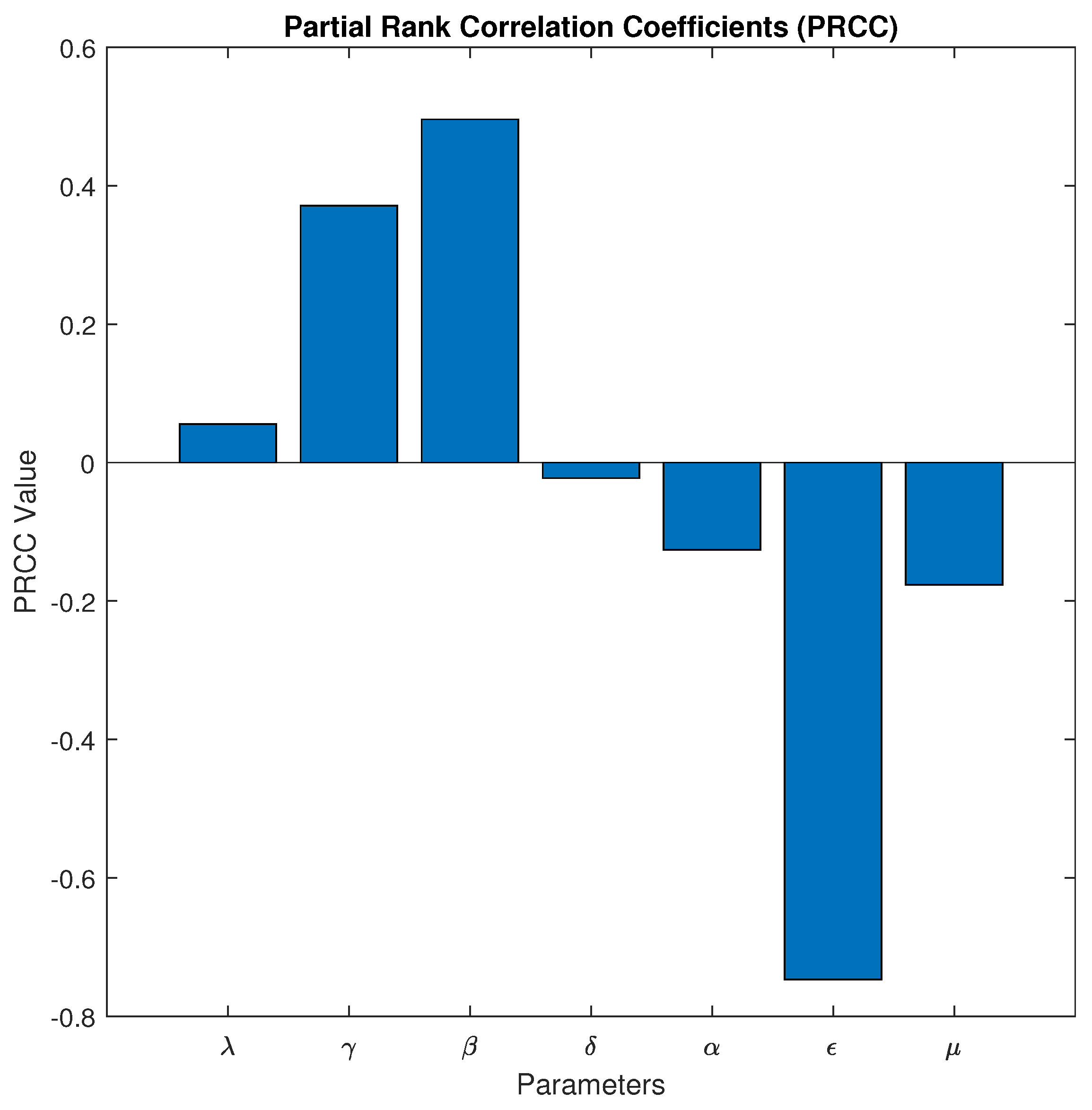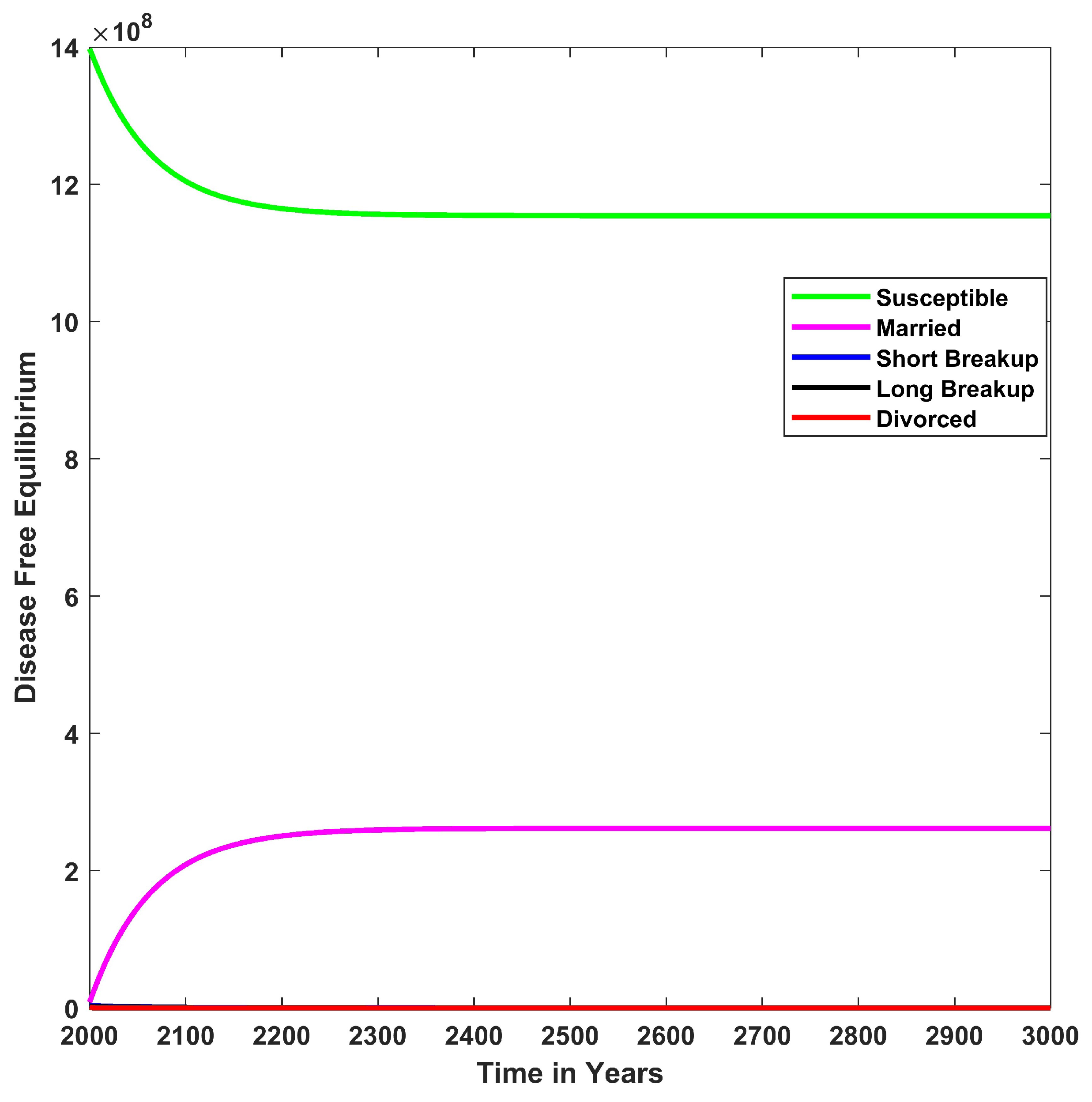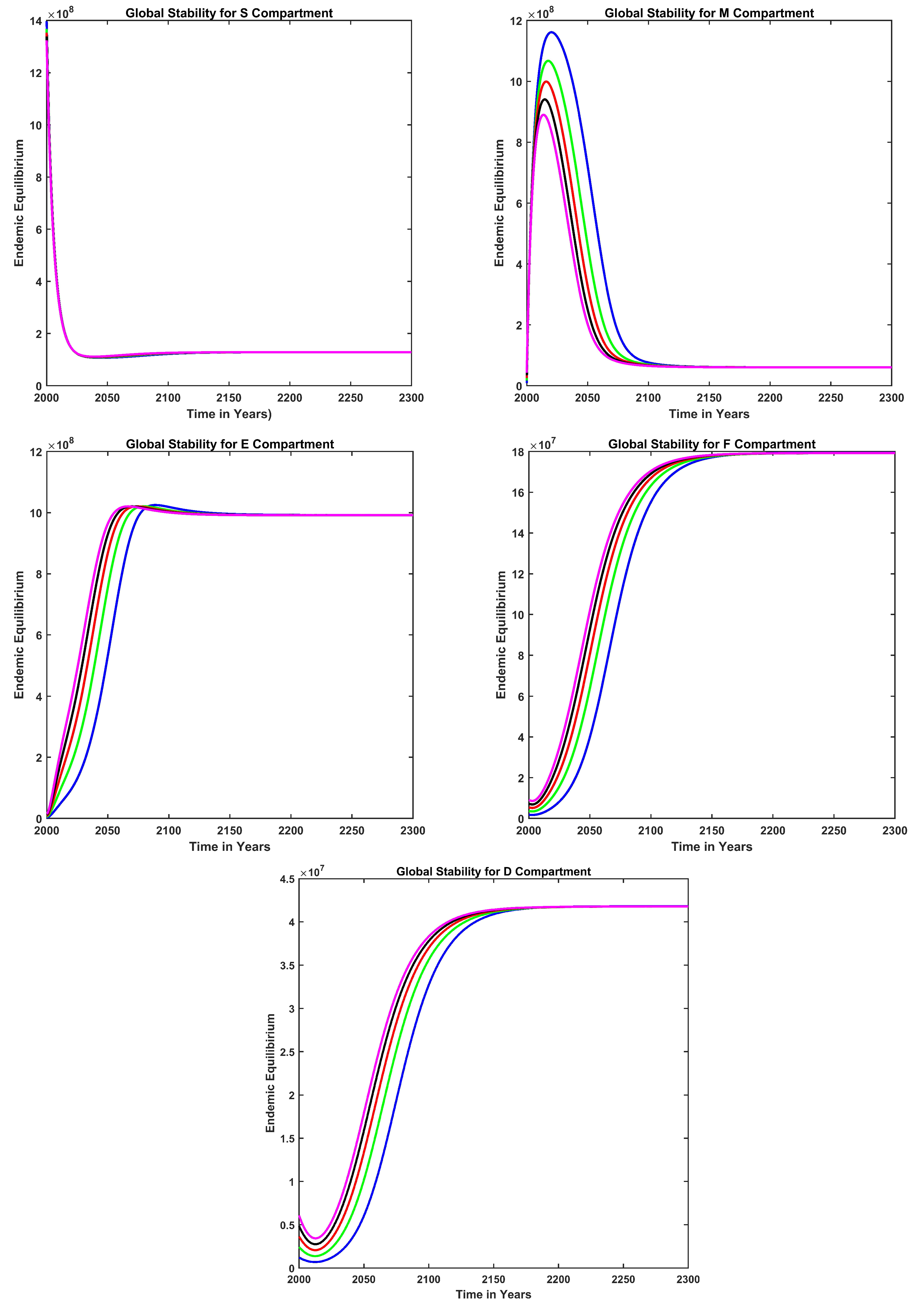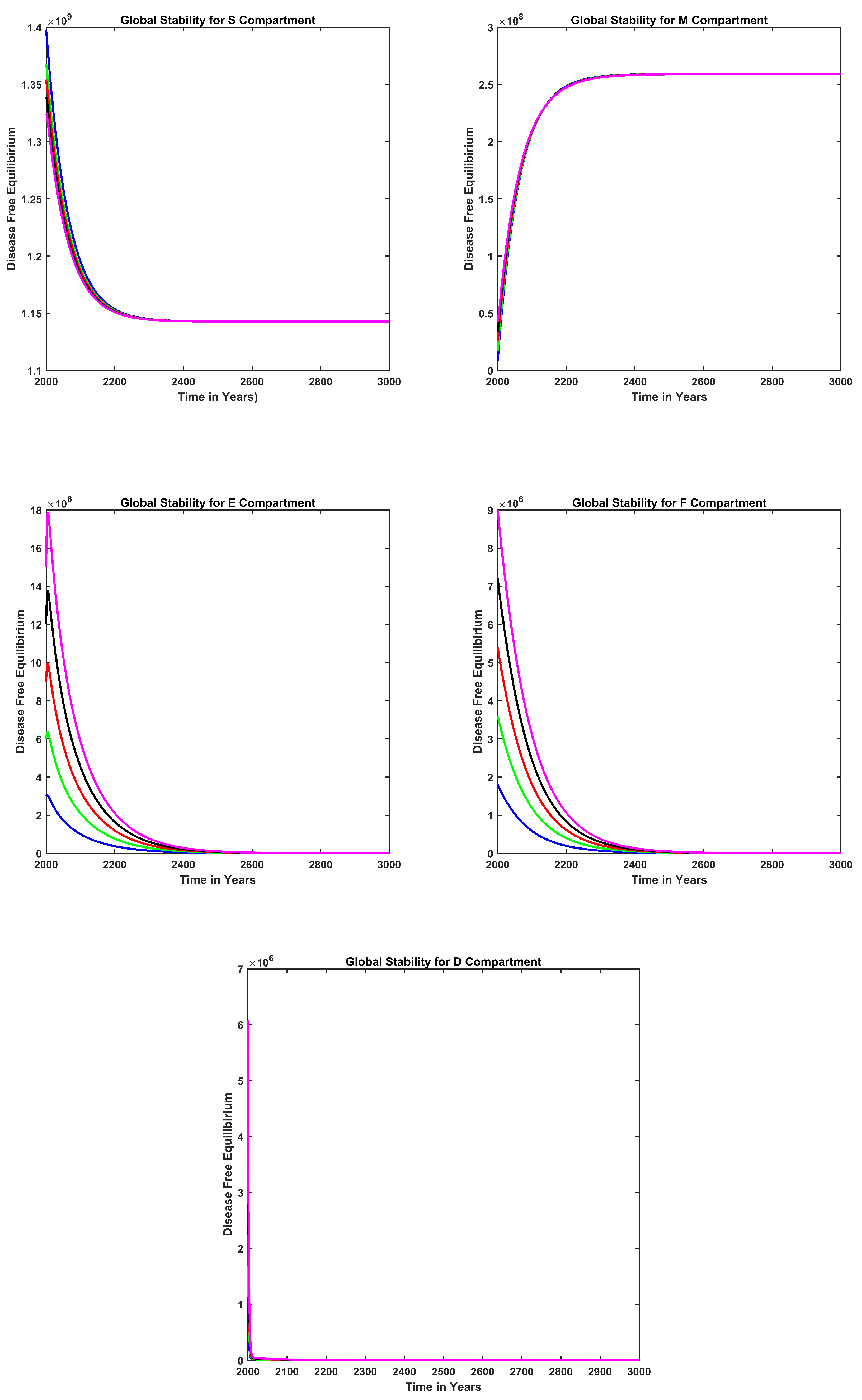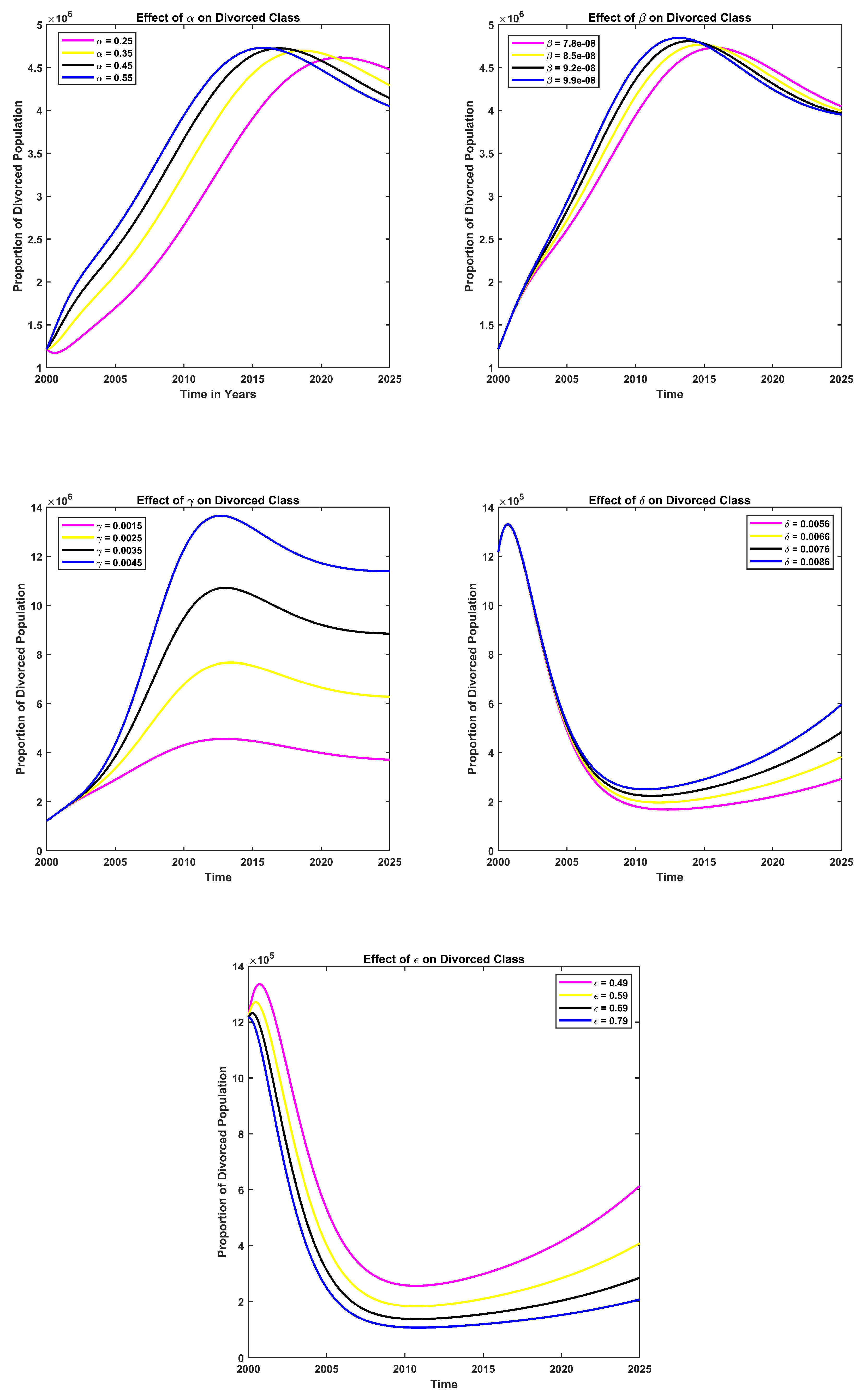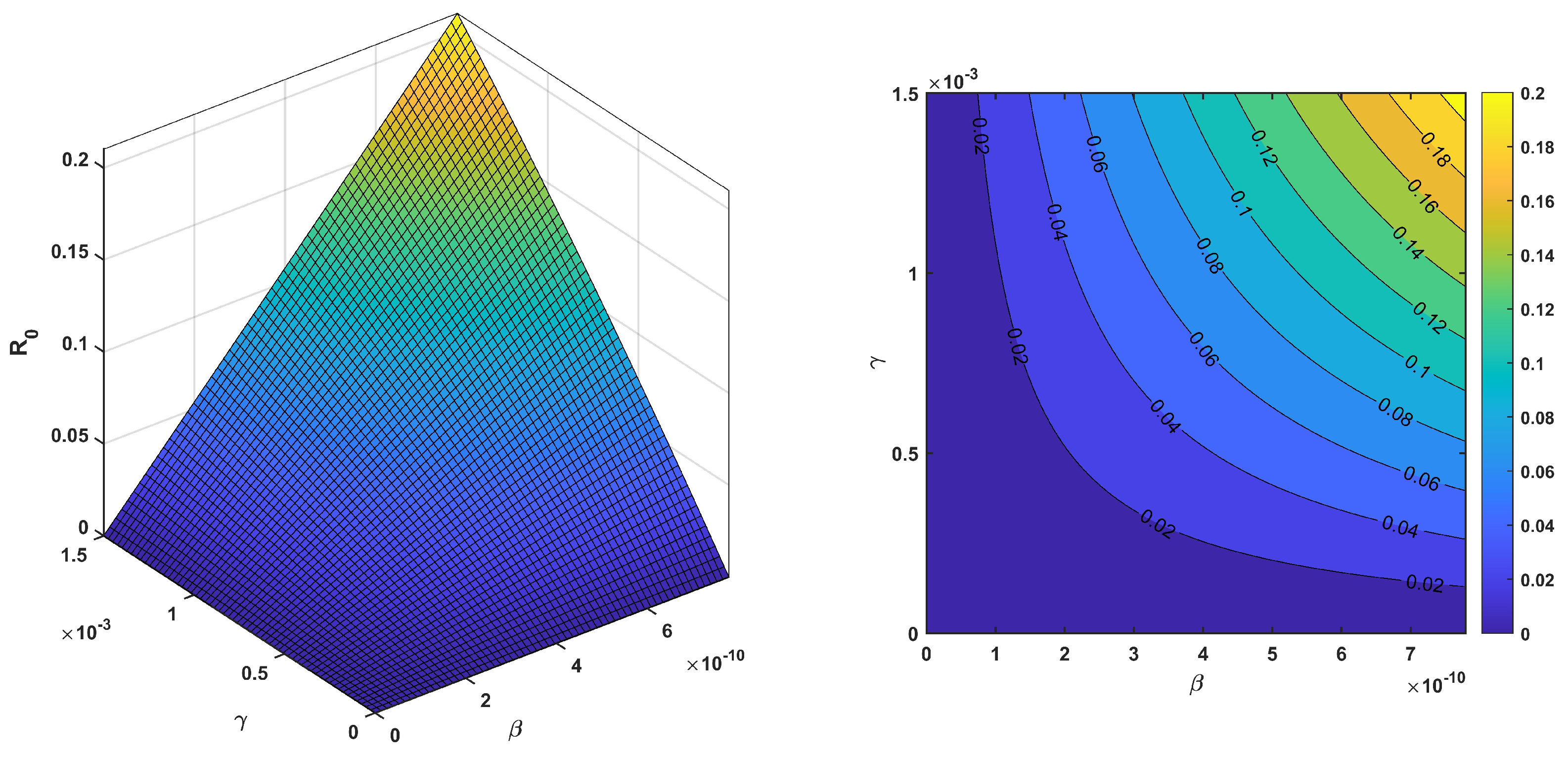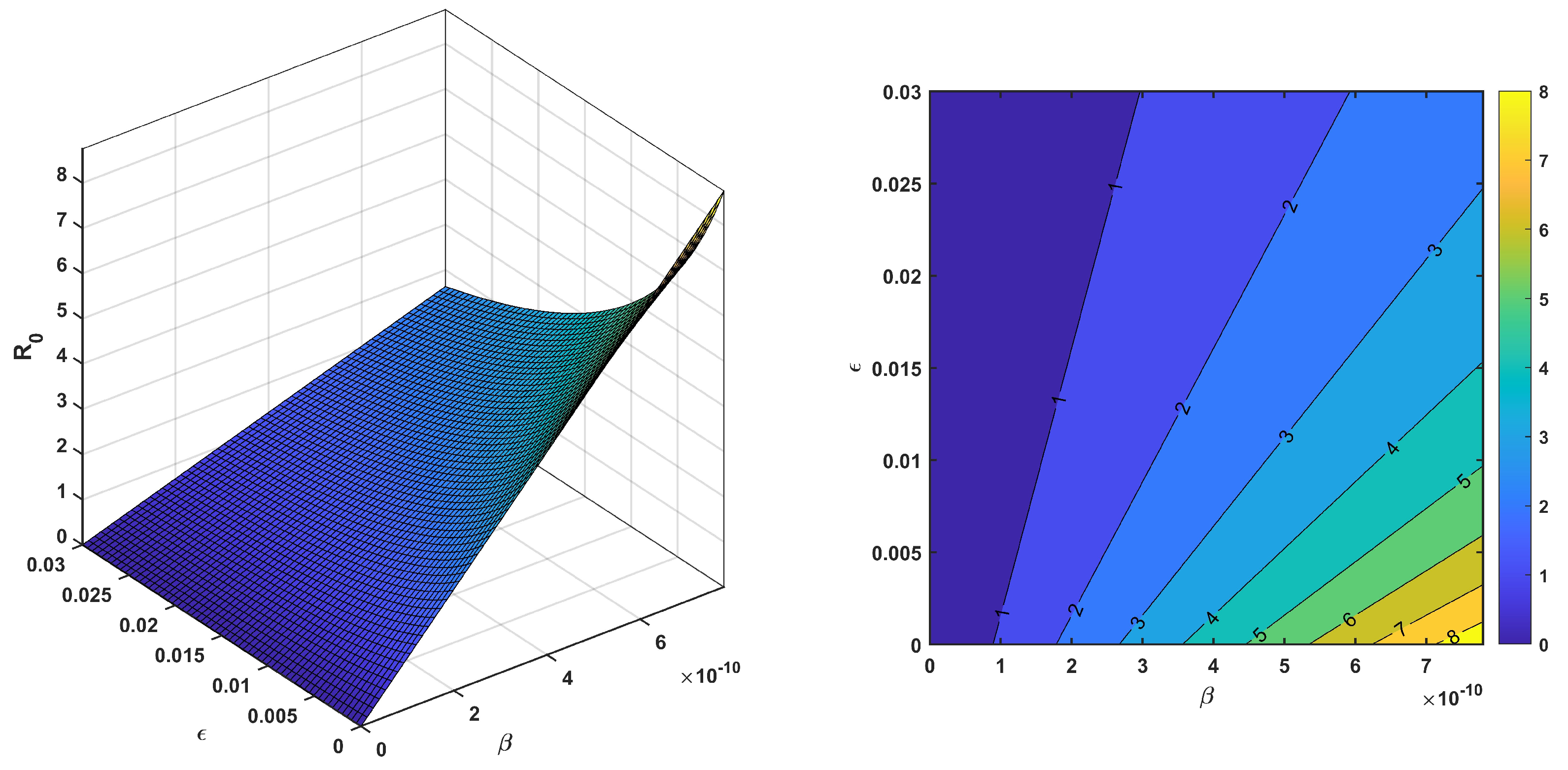1. Introduction
Divorce, characterized as the formal termination of marriage, represents a significant socio–legal phenomenon that has garnered considerable scholarly attention across diverse academic fields. Initially analyzed within the realms of law and ethics, the focus has shifted towards understanding its psychological and social ramifications. Studies suggest that the precipitants of divorce are complex and multifarious, encompassing issues like failures in communication, economic duress, unfaithfulness, and shifts in personal values or life objectives. Amato and Previti (2003) in [
1] posit that individual dissatisfaction and relational dynamics are pivotal in the disintegration of marital unions, underlining the nuanced interconnection between personal discontent and couple interactions. As cultural perceptions evolve, the stigma around divorce waxes and wanes, mirroring broader societal shifts in views on marriage, gender roles, and personal independence.
Variations in divorce rates are evident across different regions and are shaped by socio–economic, cultural, and legal influences. For instance, in the United States, there has been a notable trend towards the stabilization or reduction of divorce rates in recent years, which has been partially attributed to older ages at first marriage and greater societal acceptance of pre-marital cohabitation (Copen, Daniels, Vespa, Mosher, 2012 in [
2]). On the global stage, the divorce prevalence differs markedly, influenced by local cultural prohibitions and economic limitations. Ongoing research endeavors to elucidate the enduring impacts of divorce, especially on children, revealing diverse consequences for emotional well-being, educational achievement, and subsequent relationship stability. The dynamic and evolving nature of divorce, characterized by both its origins and repercussions, continues to be a focal point of scholarly inquiry, emphasizing the complex interrelation between individual choices and societal frameworks.
The ramifications of divorce permeate well beyond the immediate emotional and legal dissolution of a marriage, profoundly affecting all involved parties, including the spouses and their children. For the partners, the repercussions are complex and multi-dimensional, touching emotional, financial, and social aspects of life. Research frequently underscores the emotional distress faced by individuals undergoing divorce, manifesting as loss, anger, depression, and anxiety. For example, in [
3], Amato (2000) observed that individuals who have undergone divorce tend to report lower well-being levels compared to those who remain married, with these adverse effects often persisting years after the divorce has been finalized. Financially, the division of assets, coupled with potential decreases in income and increases in living expenses, can lead to economic instability. This issue disproportionately affects women, particularly those who may have been out of the workforce for extended periods. Socially, divorce often necessitates the reorganization of friendships and family relations, compelling the formation of new social networks. Children, though not direct participants in the divorce proceedings, encounter a distinct set of challenges with potential long-term consequences. Research indicates that children from divorced families are prone to educational disruptions, behavioral issues, and a heightened risk of mental health problems. Kelly and Emery (2003) in their landmark longitudinal study [
4] noted that although most children adjust over time, they initially experience significant negative impacts, including distress, anger, and disbelief.
On a broader scale, the societal implications of divorce are considerable, influencing community structures and norms. Fluctuating divorce rates can affect community stability, alter familial configurations, and modify societal views on marriage and family life. Economically, an increase in divorce rates may intensify demands on social service systems and housing needs. Culturally, as societies contend with rising divorce occurrences, there may be changes in the stigma associated with divorce, variations in marriage and cohabitation trends, and evolution in legal norms related to family rights and responsibilities. Therefore, the extensive effects of divorce at both the micro and macro levels are significant, necessitating continued research to enhance its understanding and address its impacts.
Ordinary differential equations (ODEs) are essential in epidemiology because they provide a structure for simulating the movement of infectious illnesses within populations [
5,
6,
7]. Mathematical models like the SIR model categorize the population into distinct compartments, including susceptible, infected, and recovered individuals. These models employ ODEs to depict the movement of individuals between these compartments over time, taking into account parameters like transmission rates and recovery rates. Through solving these equations, scientists are able to forecast the propagation of diseases, gauge the effectiveness of measures like vaccination and social distancing, and evaluate the contributing causes of outbreaks. ODE-based models are crucial tools for public health officials to strategize and execute successful disease control and prevention measures.
We employ mathematical epidemiology, particularly, models based on ODEs, to simulate divorce because it effectively analyzes dynamic systems, similar to how infectious diseases propagate. Using ODEs, which let us figure out important factors that affect things, look at complex relationships, and predict future patterns, we can accurately describe how quickly divorce spreads through social networks. These models offer a versatile framework for integrating many societal and individual elements, providing insights into the mechanisms that cause divorce. Furthermore, ODE-based models are valuable in formulating social policies and interventions because they can pinpoint key areas where even minor adjustments can have a significant effect on divorce rates. This makes ODE-based models a reliable instrument for comprehending and tackling the complexities of divorce dynamics.
Mathematical models of divorce are essential for comprehending the intricate dynamics that impact the stability and termination of marriages. By utilizing these models, researchers and policymakers may forecast divorce rates, discern underlying causes that contribute to marital breakdowns, and assess the efficacy of measures aimed at enhancing marriages. Comprehending this is crucial not just for scholarly investigation but also for developing strategies that could mitigate the societal and individual expenses linked to divorce. An efficient method for statistically modeling divorce is by using ODEs. These equations can mathematically represent the rate at which the condition of a marital relationship changes over time. Researchers can simulate alternative scenarios and results by establishing differential equations that mirror different features of marital interactions. For example, the model can include variables that indicate positive interactions, such as communication and shared interests, as well as negative interactions like disagreements and discontent. To assess the stability of a marital relationship, one might examine the equilibrium points of the system, where the rates of positive and negative interactions are in balance. Gottman and Murray [
8], researchers in the field, employed this method to forecast marital dissolution by creating a system of ODEs using longitudinal couple data. Their findings indicated that the model was able to accurately predict divorce with considerable precision.
The theoretical basis for employing ODEs in divorce modeling often entails formulating a hypothesis regarding the factors that contribute to divorce and subsequently converting these variables into mathematical expressions. For example, factors such as love, satisfaction, and conflict can be depicted as functions that dynamically evolve over time based on their mutual influences. The parameters of the model can be obtained from empirical data, which are usually collected through surveys or longitudinal studies and are subsequently utilized to solve the differential equations. The answers to these equations facilitate comprehension of how alterations in one dimension of the connection impact the other variables. An examination of the model through theoretical research, including stability analysis and bifurcation theory, aids in the identification of crucial thresholds at which a marriage may transition from a stable to an unstable state, potentially resulting in separation or divorce. This modeling technique not only helps us understand the changes and processes involved in marriage breakdown, but it also gives a quantitative method for assessing the effectiveness of interventions aimed at enhancing marital stability [
9]. Mathematical models, especially when they are validated and improved with real-world data, provide a strong perspective for analyzing and comprehending the dynamics of marital relationships. They offer both theoretical insights and practical applications in the fields of family psychology and social policy.
This manuscript is structured as follows: In
Section 2, the construction of the divorce model is elucidated.
Section 3 offers a comprehensive qualitative analysis of the model, addressing the estimation of parameters, the conditions for the existence and uniqueness of solutions, the identification of an invariant region, and the evaluation of solutions for positivity and boundedness. The stability of the divorce model is scrutinized in
Section 4, where both local and global properties of the equilibria are explored. An investigation into how various parameters influence the basic reproduction number (
) is conducted in
Section 5.
Section 6 details the evaluation of the model’s epidemiological compartments through extensive numerical simulations. The manuscript concludes in
Section 7 with a synthesis of the principal findings and a delineation of prospective directions for further research.
5. Sensitivity Analysis and PRCC
The quantity
plays a vital role in the transmission and persistence of the disease. The model parameters play an important role in the sensitivity analysis, as some parameters are more sensitive and have a substantial impact on the dynamics of the model. A sensitivity analysis can be carried out through different techniques, such as sensitivity heat map methods [
17], scatter plots [
18], Latin hypercube sampling–partial rank correlation coefficients [
19], and the Morris [
20], Sobol’ [
21], and normalized forward sensitivity index techniques [
22].
Taking into account both the input and output values, the normalized forward sensitivity index (NFSI) measures how much the output of a model changes when an input parameter changes in a proportional way. Mathematically, it can be written as:
Using the formula in (
37), all the values of the model parameters are evaluated and are presented in
Table 4. The basic reproduction number,
, is dependent on the sign of the parameters in the sensitivity analysis. A positive sign indicates that
will increase as the parameter increases, whereas a negative sign indicates that
will decrease as the parameter increases. In
Table 4, the parameters
,
,
, and
have positive signs, whereas
and
have negative signs. For example, if
increases by 10%, it will increase the value of
by 0.221683%, whereas if
increases by 10%, the value of
will decrease by 9.74705%.
PRCC is an acronym in mathematical epidemiology that stands for the “partial rank correlation coefficient”. We employ Spearman’s rank correlation coefficient to quantitatively assess the magnitude and direction of the monotonic association between a model’s input and its output while keeping all other inputs constant. When addressing nonlinear and non-monotonic connections, which are commonly observed in epidemiological models, it is especially beneficial. The PRCC helps researchers understand how parameter variations affect the outcomes of intricate epidemiological models. For instance, researchers can use it to investigate how altering the infection or recovery rate in a disease spread model affects the total number of infected individuals over time. This understanding is essential for creating efficient therapies and comprehending the mechanisms of illness transmission.
Computing the PRCC involves determining the correlation coefficient between the ranks of a parameter and the output while taking into account the ranks of all other parameters. This technique is highly beneficial in sensitivity analysis, as it plays a crucial role in evaluating the influence of each parameter on model outputs. This information is necessary for model validation and refinement. To do a PRCC analysis on our proposed model (
1), it is imperative that we have all the requisite data and parameters accurately described and readily available. In discussing the essential details and necessary steps for setting up and executing a PRCC analysis for a divorce model, we first outline the parameter ranges for each variable
, ensuring these ranges realistically reflect expected system fluctuations. Next, we specify the initial population sizes for each compartment (
S,
M,
E,
F, and
D). The simulation configuration includes determining the duration and the increment size for numerical integration. Additionally, we establish the desired number of Monte Carlo samples, typically 1000, to ensure statistical robustness. The MATLAB software 9.8.0.1323502 (R2020a) programming environment is also used for conducting simulations and PRCC computations. We then determine relevant model outputs for correlation analysis, such as the ultimate count of individuals who have gone through a divorce, denoted as
. With these components established, parameter sets are sampled based on defined probability distributions, and simulations are conducted for each configuration to generate output data. The process involves computing rankings of parameters and outputs and calculating the PRCC values to assess the sensitivity of model outputs to individual parameters, accounting for the influence of all other factors.
The PRCC shown in
Figure 3 reveals the individual impacts of different model parameters on the divorce model’s outcome
. The recruitment rate (
) and the rate of short breakup individuals moving to a long breakup (
) exhibit negative correlations, implying that an increase in these rates leads to a decrease in the outcome variable
. This suggests a potential stabilization or decline in the progression through the stages of the model. Conversely, there is a positive relationship between the rate at which single individuals get married (
) and the contact rate between married and divorced individuals (
). This means that higher rates of marriage and contact accelerate or strengthen the modeled processes, potentially resulting in more transitions between states. Significantly, the divorce rate (
) and the natural death rate (
) have notable negative effects on individuals who have long breakups. This implies that these parameters may function as inhibiting factors in the model dynamics, potentially slowing down or decreasing the number of transitions into the divorce or death states. This research facilitates the comprehension of the most relevant elements and their impact on the behavior of the system, offering a quantitative foundation for targeted interventions or more exploratory studies.
6. Numerical Results and Discussion
The numerical results provide a comprehensive understanding of divorce trends in China. The population of China stands at 1,411,800,060 [
23]. Initially, the population classes are assumed to be:
= 1,397,291,546,
M(0) = 8,491,781,
E(0) = 3,000,000,
= 1,800,000, and
= 1,216,733. The numerical values, fitted using real data, indicate that when
, the solution converges to the endemic equilibrium at
, as depicted in
Figure 4. Conversely, numerical simulations show that when
, the solution converges to the disease-free equilibrium
, as shown in
Figure 5. Therefore, the system is locally stable, as evident in
Figure 4 and
Figure 5. Furthermore, under different initial conditions with
(
Figure 6), all the solutions converge to the endemic equilibrium at
, whereas with
(
Figure 7), all the solutions converge to the disease-free equilibrium
. Therefore, the system is globally stable, as evident in
Figure 6 and
Figure 7.
The impacts of various parameters are illustrated in
Figure 8. For instance, the effect of
on the divorced class is depicted first and clearly demonstrates that an increase in
leads to a higher divorce rate. Similarly, the effects of
,
, and
are observed. In contrast, the effect of
on the divorced class is shown, where an increase in
results in a decrease in the divorce rate.
Figure 9 shows two different types of plots related to
for the proposed divorce epidemic. The quantity
represents the expected number of cases directly generated by one case in a population in which all individuals are susceptible to divorce. The first plot on the left in
Figure 9 is a three-dimensional surface plot that shows the relationship between
, the contact rate (
), and the divorce rate (
). The parameter
is represented on the horizontal axis and ranges from 0 to 1, and
is represented on the depth axis and ranges from 0 to 0.001. The vertical axis represents
, which appears to increase as either
or
increases. This suggests that higher contact rates or divorce rates both lead to a higher
, indicating a more severe potential outbreak.
The second plot on the right in
Figure 9 is a contour plot that provides a top-down view of the same data, projecting the three-dimensional relationship onto two dimensions. The color scale on the right side of the plot indicates the values of
corresponding to the colors on the plot. The contour lines represent different levels of
, showing how combinations of
and
correspond to the same
. In regions where the contour lines are close together, small changes in
or
result in large changes in
, indicating sensitive areas of the parameter space where control measures could have significant impacts on the spread of divorce.
In
Figure 9, it can be observed that
increases when
and
increase. If
increases but
is very small, then
is small and vice versa. Both plots are valuable for understanding how changes in the contact rate and divorce rate impact the spread of divorce. Such models are crucial for public health planning and interventions, allowing experts to simulate various scenarios and formulate strategies to control or prevent outbreaks. In
Figure 10, it can be observed that
increases when
and
both increase. If
increases and
is very low, then
is smaller and vice versa. In
Figure 11, it can be observed that
increases when
and
both increase. If
increases and
is very low, then
is smaller. In
Figure 12, it can be observed that
decreases when
and
both increase. Therefore, the parameter
plays a vital role in controlling divorce, as if
increases, then divorce can still be controlled. In
Figure 13, it can be observed that
decreases when
increases, whereas if
increases, then
also increases. If
and
both increase, then
is smaller. Therefore,
plays a vital role in controlling divorce, as if
increases, then divorce can still be controlled due to
.
7. Conclusions and Future Remarks
In this study, we developed a deterministic model to analyze the dynamics of divorce transmission by utilizing a system of nonlinear ODEs. By employing real data from China spanning the years 2000 to 2020, as reported by Statista, we estimated the model parameters effectively. The number , a pivotal metric in our analysis, was derived using the next-generation matrix method. This model demonstrates both local and global asymptotic stability at disease-free and endemic equilibria.
Significantly, our findings underscore the critical role of in the potential for divorce to become epidemic; values above one predict widespread transmission, while values below one suggest containment. Among the parameters, proved to be highly influential, whereas and exhibited a positive impact on . Conversely, tended to reduce . A key objective derived from this understanding is to strategically lower to mitigate the spread of divorce. Our proposed strategies include reducing contact rates between single and married individuals and enhancing the propensity for remarriage among divorced individuals. Theoretical predictions were supported by numerical simulations, which are visually represented to validate the analytical outcomes.
For future research, it would be advantageous to explore the impact of sociocultural factors on the transmission dynamics of divorce. Additional parameters, such as the effects of legal and psychological support systems, could be integrated into the model to provide a more comprehensive understanding. Moreover, comparative studies involving data from different regions or countries could shed light on global patterns and the effectiveness of various intervention strategies. Through such endeavors, we can further refine our model and contribute to more effective societal strategies to manage and possibly reduce the incidence of divorce.


